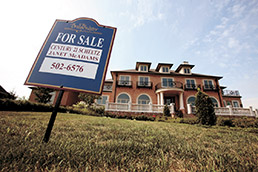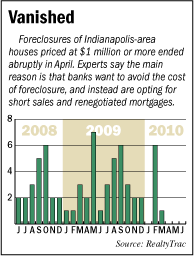Subscriber Benefit
As a subscriber you can listen to articles at work, in the car, or while you work out. Subscribe Now
Until this year, Indiana’s foreclosure epidemic knew no demographic boundaries. über-expensive homes, those priced
at $1 million or more, skidded into foreclosure right alongside starter houses in the most notorious vinyl villages.
But suddenly that’s changed. Since March, not a single foreclosure on a house priced at $1 million or more has been
filed in the Indianapolis area—a possible sign of better times ahead in a niche where selling prices are down 20 percent
or more from their peak in 2005 and 2006.

This mansion at 15371 Whistling Lane in Carmel was built on speculation for $2.3 million, but is now listed for $1.5 million.
(IBJ Photo/ Perry Reichanadter)
The pullback follows more than 60 filings in the segment in the past two years, according to RealtyTrac, an Irvine, Calif.,
firm that tracks default notices, auction sale notices and bank repossessions.
Overall, foreclosure filings are on the upswing in the Indianapolis area, rising 22 percent, to nearly 20,000, in the 12
months that ended in May.
Just about everyone but prospective buyers wishes the blight would go away.
Many of the million-dollar homes ending up in foreclosure were owned by executives who found themselves unable to pay mortgages
after losing jobs or businesses, or going through a divorce or suffering health problems.
Others were owned by contractors who built on speculation and then saw demand for mansions vanish almost overnight as the
economy skidded into recession.
As much as lenders, real estate brokers and other observers would like to throw a party over the foreclosure reprieve among
the area’s swankiest homes, they caution against reading too much into it. The market is warming, they say, but not
in a big way, and many of the underlying conditions are still miserable.
What’s changed most, the experts say, is bankers’ discovery that foreclosure is more expensive than they thought.
Ramrodding a property into the ignominious end floods an already soggy market and saddles the banks with property taxes,
insurance and lawns to mow—not to mention replacing stolen copper and fixing water pipes that burst after utilities
are flipped off.
Some banks are instead unloading houses through short sales, meaning the house sells for less than the value of the mortgage
balance. Banks also have resorted to renegotiating mortgages on to-die-for terms, keeping the homeowner around to pay basic
expenses in the hope the market will improve and the house can be sold for a higher price.
The upshot is that buyers are still king. In some cases, they’re scooping up properties for 60 cents on the dollar,
and there’s little reason to believe they’ll be pushed off their thrones anytime soon.
“If we’re not at the bottom of pricing, we’re close,” said Indianapolis real estate broker Mike Woods,
who is bottom-fishing for property as a personal investment. “It’s a fabulous time to buy. It will go back up,
even if it’s just a matter of time.”
Foreclosures continue to plague Indiana along with the nation.
RealtyTrac chronicled 14,574 foreclosures in Indiana during the second quarter. That was up 10.3 percent from the first quarter
and 5.1 percent from the second quarter last year.
Nationally, foreclosures fell 4 percent, to 895,521, from the prior quarter and increased 1 percent from the second quarter
of 2009.
RealtyTrac said foreclosures lost favor with lenders in the most recent quarter as they turned to more aggressive short sales
and loan modifications.
Changing attitudes
The foreclosure calm in the million-dollar-plus home market might be a statistical blip. The tiny number of houses
in that price range makes it risky to draw conclusions. Only five of the 226 currently for sale in Marion County and surrounding
counties through the Multiple Listing Service are owned by banks.
Yet, as RealtyTrac noted in its national analysis, local experts see the drop-off coinciding with a noticeable change in
attitude by lenders, most of which are huge institutions such as Bank of America, Countrywide, Chase and Wells Fargo.
 “There has been a trend where the banks don’t necessarily want the more expensive
“There has been a trend where the banks don’t necessarily want the more expensive
homes back,” said Fred Krawczyk, who helps homeowners negotiate with lenders via his Heritage Partners LLC in Carmel.
“They sit on them longer.”
Chase spokeswoman Nancy Norris said the bank’s strategy has not changed. Chase has always preferred changing the loan
to keep homeowners on site, Norris said, because foreclosures are expensive for the bank and drag down neighborhoods.
However, Chase has beefed up staff to process short sales, which cost banks less than foreclosure.
“Homeowners are more aware now of what their options are than they were perhaps a year or two ago,” Norris said.
Others familiar with bank strategies say lenders clearly are looking for different ways to minimize losses on white-elephant
properties.
Banks initially thought pushing houses into foreclosure was the quickest way to get the problem mortgages off the books.
But the aggression gave way to angst as listings languished and maintenance costs mounted. Would-be buyers feared stepping
into mortgage commitments or couldn’t because they’d seen their businesses or jobs founder.
Complicating matters was the broken financial system.
Government-sponsored enterprises such as Fannie Mae and Freddie Mac that buy many of the nation’s mortgages are functioning
again, but they don’t gobble up so-called jumbo loans—mortgages above $417,000. And many of the investors that
had, including insurers and pension funds, are chastened by massive losses.
As a result, when banks make the loans, they go in knowing full well they’ll likely be stuck with them. So banks have
taken to demanding steep down payments, sometimes upward of 35 percent, to cushion against default and the potential they’ll
have to unload the property at a steep discount.
Some experts say banks also have pulled back from foreclosing on expensive properties to avoid shedding unwelcome light on
the depressed values. Keep a house off the market, and no one but the bank knows its value; list the house, and the bank must
show the loss on its balance sheet.
Alternatives to foreclosure aren’t exactly attractive to lenders, either.
Many are jettisoning properties through short sales and wincing as they absorb losses.
Banks also are renegotiating mortgages. One loan officer said a friend who lives on Geist Reservoir stood to lose the house
until the friend’s lender allowed him to restructure the mortgage to a whopping 40 years at a mere 2-percent interest.
If the friend ever sells the house and makes money, the bank is entitled to recoup some of its lost interest.
As with many such restructurings, only the homeowner and bank know the property was distressed.
Buyers’ gain
As ugly as the market is for sellers, it’s a veritable smorgasbord for buyers.
Real estate brokers say houses priced above $1 million are going for a minimum of 20 percent off peak levels of 2005 and
2006. In extreme cases, values are slashed by nearly half.
The depth of the discounts often depends as much on location and quality as the banks’ desperation to spin off inventory.
Cul-de-sacs and other locations with low traffic are holding up best, said Greg Cooper, a broker at the Dick Richwine Group
within Prudential Indiana. But the houses also must have high-end touches like stainless-steel appliances, kitchen countertops
made of Corian or better, crown moldings, finished basements and huge closets.
Some houses may not recover their peak values for decades: Think once-expensive locations off the water at Geist or houses
like the $1 million listing Cooper toured recently that had hollow doors.
Real estate brokers say tire-kickers have started to emerge in recent months. Jim Litten, president of brokerage F.C. Tucker
Co., has seen more interest in the market so far this year than all of last year.
The market for $1 million houses promises to stay soft for at least two years and probably five or more, brokers say. At
the outside, the funk could last a decade.
That’s because, as soon as the market gains any momentum, homeowners who sat out the downturn will begin putting their
houses on the market and keep prices suppressed.
The market also won’t be saturated anytime soon by new houses. Construction costs are 20 percent to 30 percent higher
than the cost of buying an existing house that has yet to see its first occupant.
About the only people who will build will be those who can’t find an existing house they like.•
Please enable JavaScript to view this content.
